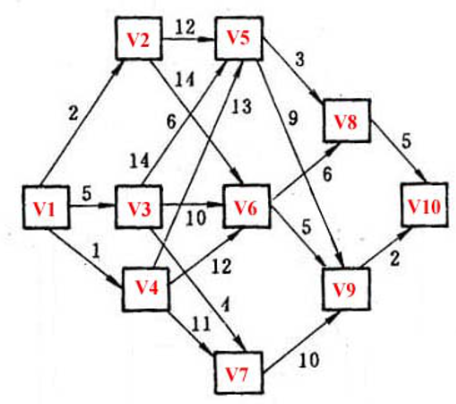Floyd最短路及路径输出
引例
下图表示城市之间的交通路网,线段上的数字表示费用。如图,求$V_{1}$→$V_{n}$最短路径长度及路径

样例数据
输入
10 0 2 5 1 0 0 0 0 0 0 0 0 0 0 12 14 0 0 0 0 0 0 0 0 6 10 4 0 0 0 0 0 0 0 13 12 11 0 0 0 0 0 0 0 0 0 0 3 9 0 0 0 0 0 0 0 0 6 5 0 0 0 0 0 0 0 0 0 10 0 0 0 0 0 0 0 0 0 0 5 0 0 0 0 0 0 0 0 0 2 0 0 0 0 0 0 0 0 0 0
输出
minlong=19 1 3 5 8 10
分析
用$Dp$数组记录状态并初始化之为$INF$,如果输入的$G_{i, j}$不是0则$Dp_{i, j}$ = $G_{i, j}$。裸$Floyd$,$Path$数组记录路径,递归输出,输出时勿忘判断此时是否存在$Path$,且要先输出1因为从1开始且1不会被判断到
代码
#include <bits/stdc++.h> #define Enter puts("") #define Space putchar(' ') using namespace std; typedef long long ll; typedef double Db; const int INF = 0x3f3f3f; //template <typename T> inline ll Read() { ll Ans = 0; char Ch = getchar() , Las = ' '; while(!isdigit(Ch)) { Las = Ch; Ch = getchar(); } while(isdigit(Ch)) { Ans = (Ans << 3) + (Ans << 1) + Ch - '0'; Ch = getchar(); } if(Las == '-') Ans = -Ans; return Ans; } inline void Write(ll x) { if(x < 0) { x = -x; putchar('-'); } if(x >= 10) Write(x / 10); putchar(x % 10 + '0'); } int G[1001][1001]; int n; int Dp[1001][1001]; int Path[1001][1001]; inline void Print_Path(int x , int y) { if(x == y) { printf("%d" , x); return ; } int k = Path[x][y]; if(Path[x][y]) Print_Path(x , k); printf("%d " , y); } /*inline void Init() { for(int i = 1; i <= n; i ++ ) for(int j = 1; j <= n; j ++ ) { if(i == j) Dp[i][j] = 0; else Dp[i][j] = INF; Path[i][j] = i; } }*/ int main() { n = Read(); //Init(); memset(Dp , INF , sizeof(Dp)); for(int i = 1; i <= n; i++) for(int j = 1; j <= n; j++) { G[i][j] = Read(); if(G[i][j]) Dp[i][j] = G[i][j]; } /* for(int i = 1; i <= n; i++) for(int j = 1; j <= n; j++) if(!Dp[i][j]) Dp[i][j] = INF; */ for(int i = 1; i <= n; i++) Dp[i][i] = 0; for(int k = 1; k <= n; k++) for(int i = 1; i <= n; i++) for(int j = 1; j <= n; j++) { if(Dp[i][j] > Dp[i][k] + Dp[k][j]) { Dp[i][j] = Dp[i][k] + Dp[k][j]; Path[i][j] = k; } } printf("minlong=%d" , Dp[1][n]); Enter; cout << "1 "; Print_Path(1 , n); return 0; }

